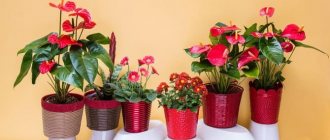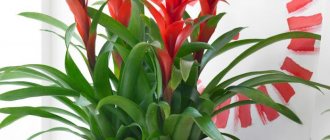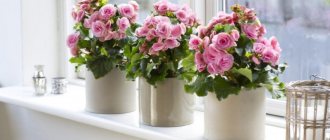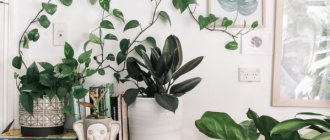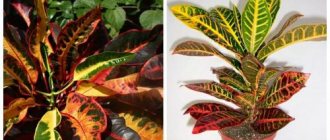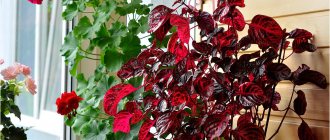House plants: properties, usefulness and harm
Many years of practice and experience confirm the sanitary, aesthetic and hygienic role of most indoor plants. They help clean the air from carbon dioxide. It is usually 23 times more abundant indoors than outdoors.
Thanks to flowers, the air is enriched with oxygen. The leaves of indoor plants evaporate moisture, humidifying the air and reducing its temperature.
Natural green color has a beneficial effect on the nervous system and psyche. People's mood and performance improves.
Particularly valuable are plants that secrete essential oils and phytoncides that have the ability to kill pathogens. About 50 species of such indoor plants are currently known. Doctors together with chemists and botanists study their properties.
There are also “doctors” among them (for example, aloe and kalanchoe, golden mustache and geranium).
You should not grow poisonous plants at home, and if you have them, handle them with caution. These include milkweed, oleander, alocasia and acalypha. If you like such indoor plants and look good, it is advisable to place them in a place inaccessible to children, and be careful when in contact with them.
Progress of joint activities:
1. Motivational - indicative stage
- Look how many plants we have in our group . Do you know these plants ? How to properly care for them?
- What groups can we divide these plants ? Why?
- Where do you think these plants came from ?
2. Search stage
Examination of illustrations depicting the warm forests of India and the hot forests of Africa.
- What do we need to do to find out the homeland of these plants ?
(research methods are laid out on the board: “think”
,
“ask adults”
,
“read in a book”
,
“look on the Internet”
)
plants might come from
Plan option: make an assumption about the homeland of plants , compare with plants of the proposed area, describe the features of caring for the plant
—Where do we start our research?
3. Practical stage.
— To quickly conduct research, I suggest you divide into two groups .
(From ready-made models, children lay out the region, determine the differences and similarities, schematically sketch the structure of the plant , features of adaptation to the climate)
Begonias often grow in India in tropical, moist, shaded areas, on old trees and roots. Why do many begonias have such large leaves? In the tropical forest there are a lot of trees, through the foliage of which little light reaches the ground. Larger leaves can catch more sunlight.
Kinds
Houseplants, according to their decorative properties, are usually divided into 3 large groups. The plants of the first two are decorative-leaved and decorative-flowering indoor plants that do not lose their attractiveness throughout the year. The third group is ornamental flowering plants that attract attention only during flowering periods.
In addition to all this, among the plants grown at home, there are separate groups: palm trees, orchids, bromeliads, cacti and succulents, ferns, bulbous plants, and also fruit-bearing plants.
Indoor plants and their homeland - the tropics
The tropics are located in the equatorial zone. The most common tropical landscape is evergreen forest, called jungle. The climate of the tropical zone is characterized by slight fluctuations in year-round temperature, a large amount of moisture both in the air and in loose fertile soil. Plants found in the jungle have different relationships to sunlight. This is explained by their multi-tiered nature in the tropical forest, where there is always partial shade under the dense crowns of trees. Plants from the tropics are moisture-loving, shade-tolerant, preferring loose, fertile soil. They need to be fed frequently and, in most cases, shaded from the sun.
Article on the topic: How to grow cyclamen from seeds
In forests located in the tropical zone, most of all the ancestors of indoor plants grow. This is the habitat of all kinds of vines, ferns, ornamental flowering plants with unusual beautiful flowers. In the struggle for a ray of light, a new species of plants has formed here, living on trees, receiving nutrients from the air - epiphytes. Epiphytes of the tropics include orchids and some types of bromeliads. These plants are light-loving; in apartment conditions they need sufficient lighting. Winter room temperatures, comfortable for the green inhabitants of the tropics, should not be lower than 20 degrees. The rest period is insignificant and not clearly expressed.
Tree and shrub species of tropical plants:
Dracaena deramensis
Erantemum
See also: How to care for milkweed
Murraya paniculata
Herbaceous decorative-deciduous, decorative-flowering tropical plants:
Alocasia large-rooted
Dieffenbachia spotted
Monstera is attractive
Usambara violet (Saintpaulia)
Caring for indoor plants: rules
- Roots need not only water, but also air. Overmoistening of the soil leads to death or disease.
- In winter and late autumn, the air in rooms, mainly with central heating, is dry. You need to learn how to properly maintain its humidity.
- Almost all indoor plants require a certain period of rest. At this time, they should be watered less often and fed a little less. You also need to ensure a lower air temperature than during the period of active growth.
- A couple of years after planting, most plants lose their attractiveness. In this case, it is enough to simply transplant the flower into a larger pot.
- When caring for plants, the following tools are needed: a watering can with a narrow long spout, a sprayer, an old fork and spoon, pruning shears, a soft sponge. Good soil, pots, supports, pallets, liquid fertilizers in bottles - this is all that is needed for proper care of flowers.
- If the plant is flooded for a long time, it may die. Same with pests. If a couple of scale insects or any other insects appear, it is not difficult to fight them. And when they cover the entire plant, they cannot be defeated. This means that you should promptly recognize any future troubles for the plant and take the necessary measures to successfully combat them.
- When choosing flowers to grow indoors, be sure to take into account the conditions provided for them. There are light-loving and shade-tolerant plants.
Can a plant from the wild be brought into the home?
All indoor flowers were once inhabitants of the wild. As we can see, many of them have successfully moved into our homes and are doing quite well. What is needed for this? Just carefully study the climate of the homeland of a particular plant.
You can start right away with the soil. They can be fertile, sandy, rocky, acidic, alkaline. In fact, any one can be recreated at home or purchased ready-made.
Lighting depends on the area in which and with which neighbors the desired flower grows. After all, it can be located on bare rocks, which means it can withstand the scorching sun, or it can, on the contrary, grow at the foot of forest trees and catch the rare rays of the sun. Based on the results, the plant is placed at home on a south window or shaded.
Remember!
Air humidity and precipitation for irrigation are also of significant importance. Sometimes this is the most important point of the conditions, and deviation threatens the death of the flower. There are some exotics that require a separate box, like a personal greenhouse.
It is also worth checking whether the plant has a dormant period; it is often needed as a condition for future flowering. Sometimes this is a short daylight hours, or a decrease in air temperature, or a decrease in watering.
All this is quite different from ordinary apartment conditions; it is worth thinking carefully about whether there is an opportunity and desire to change some area of the house for the comfort of a new resident.
News from the homeland of indoor plants: what do you need to know?
Where did house plants come from and where do they grow in nature? Let's look at some of them.
- The flowering ornamental plant verbena is a perennial from the verbena family. Her homeland is America. It is used both in pot culture and when decorating flower beds on open ground.
- The evergreen gardenia shrub is a jasmine plant (180 cm) from the Rubiaceae family. Its homeland is the subtropics of China, Africa, Japan, and Asia.
- Gerbera from the Asteraceae family is native to South Africa. It is also grown both for cutting and at home.
- Hibiscus (Malvaceae family) comes from the tropics and subtropics of southeast Asia (Southern China), Polynesia, and northern India. Its entire genus numbers approximately 300 species. It should be noted that this plant lives for more than 20 years.
- Hydrangea (Hortensia family) grows naturally in China. It has been in culture since the end of the 18th century.
- Primrose from the Primrose family, uniting about 20 genera, is distributed mainly in the temperate zone of the Northern Hemisphere. Japan and China are the birthplace of the flower. There are more than 600 species in total.
The world of indoor plants is amazing and beautiful. Flowers not only decorate the design of any room and give it coziness, but also delight the eye all year round, reminding us in a snowy winter of the variety of colors of nature.
Atlas of indoor plants - Limarenko L.Yu., Paleeva T.V.
Atlas of indoor plants. Author: Limarenko L.Yu., Paleeva T.V. 2003. This compact, easy-to-use reference book will be useful in every home where indoor plants are loved and grown. It presents about 300 of the most common plants, including balcony plants. Here you will find all the necessary information: where the plant comes from, how to water and feed it, where it is best for it to winter. Brief and succinct descriptions are complemented by color photographs, from which you can easily recognize your flower.
Variety of orchid varieties
All orchid plants can be divided into 2 groups:
- Monopodial - these varieties have only one growing point and grow upward. Flower shoots emerge from the axils of the leaves;
- Sympodial - these plants grow and reproduce in a horizontal position. They resemble a vine that lies on the ground and reproduces by sending out roots from the axils of the leaf blades.
Orchids are divided into monopodial and sympodial.
There are 25,000 varieties of all orchid plants, but they are all divided into groups. The main groups of orchid plants:
- Brassia – It is believed to originate from South America. Due to its appearance, the flower has its second name - “spider orchid”. This species has 34 varieties, the most popular are considered to be B. Spotted and B. Warty;
Brassia spotted.
- Cambria is a sympodial plant with a wide variety of flowers and leaves. When purchasing this plant, you need to take a baby with 3 bulbs; if they sell one flowering one, it will die after flowering;
Cumbria.
- Cattleya is represented by 187 varieties and has beautiful large flowers. The growth of the bush is sympodial. Cattleya will bloom only when the seedling has at least 4 bulbs;
Cattleya.
- Cymbidium is a hanging plant that requires minimal care. The plant is native to Japan and Australia. It has beautiful exotic blooms with a unique aroma;
Cymbidium.
- Phalaenopsis is the most common orchid living in our homes. The flowers vary in color, but all have a flower shape that resembles a butterfly. All flowers are located on long peduncles, and the bush has a monopodial growth pattern.
Phalaenopsis.




